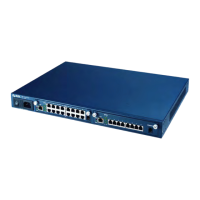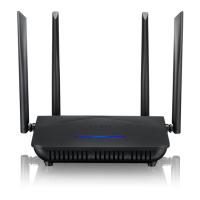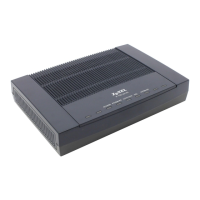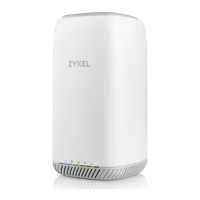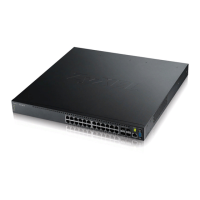IES-2000/3000 User’s Guide
11-2 IEEE 802.1QTagged VLAN Commands
11.4.2 Dynamic Entries (DVLAN Table)
Dynamic entries are learned by the bridge and cannot be created or updated by administrators. The bridge learns
this information by observing what port, source address and VLAN ID (or VID) is associated with a frame.
Entries are added and deleted using GARP VLAN Registration Protocol (GVRP), where GARP is the Generic
Attribute Registration Protocol.
11.5 Configuring the Tagged VLAN
In a typical setup, each DSL port is assigned a different VLAN ID (VID) to isolate the subscribers, while the
uplink port should be a member of every subscriber VID and the management VID. Note that on the ALC1024
and SLC1024, contrary to VLC1012, the port-based VLAN is always active; it is NOT mutually exclusive of tag-
based VLAN. On the ALC1024/SLC1024, the system performs tagged-VLAN processing first and then port-
based VLAN in tandem.
The deletion of the default management VLAN and the enabling of the VLAN MUST be the last steps in the
configuration procedure, because once you change the settings, you will not be able to connect to the line card
with your computer, which is without tagged VLAN capability. You can configure the VLAN associated with the
DSL ports before the uplink ports, or you can do this over the network after the line card is put into service.
See the examples with the following procedure.
Procedure:
Step 1. Use the IEEE 802.1Q tagged VLAN commands to configure tag-based VLAN for the subscribers.
• Use the
svlan setentry command to configure a VLAN ID for each subscriber.
For a typical setup, use
fixed for the administration control for the DSL port (numbered 2-25)
and the uplink port (number 1).
Select
untag for the tag control for the DSL port and “tag” for the uplink port.
Ignore any messages telling you to use the
enable vlan command in order to enable GVRP.
Use the
enable vlan command when you are finished configuring the VLAN (see the last
step).
• Use the
pvid command to set the VLAN ID you created for a port to that specific port in the PVID table.
• Repeat these steps for the rest of the DSL ports.
Example:
1.
192.168.1.1> vlan1q
2.
192.168.1.1 vlan1q> svlan setentry 11 2 fixed untag
3.
192.168.1.1 vlan1q> svlan setentry 11 1 fixed tag
4.
192.168.1.1 vlan1q> pvid 2 11
5.
192.168.1.1 vlan1q> svlan setentry 12 3 fixed untag
6.
192.168.1.1 vlan1q> svlan setentry 12 1 fixed tag

